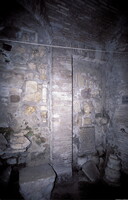San Clemente
unknown (Italian)

Download1A3-EC-SC-I8_cp.jpg (381.2Kb)
Date
380Description
Lower Church (4th century), view of other remains; A standard type of basilica and a standard type of baptistery evolved and spread throughout northern Italy, and from North Africa to southern Spain and Gaul. The standard type of basilica was meant to hold a congregation of between 800 and 1400. It consists of a nave flanked by aisles and terminating in a semicircular, sometimes rectangular, apse; a narthex and atrium sometimes feature at the west end. This standard type of basilica is known as early as the late 4th-century church of S Ambrogio at Milan, which has three aisles and a semicircular eastern apse, a plan that became widespread in northern Italy in the 5th century. After ca. 380 examples of the type at Rome include S Clemente. The schola cantorum is a term applied to nave chancels in medieval Roman churches on the basis of a supposed association with the eponymous body of papal chanters. This association originates in the misinterpretation of a 16th-century description of S Clemente by Ugonio.The form of Early Christian nave chancels was not standardized. Those at S Giovanni in Laterano (4th century) and at S Clemente (6th century) were apparently narrow passageways constructed of low parapets held together by posts and so lightweight that they did not need foundations. Source: Grove Art Online; http://www.groveart.com/ (accessed 2/3/2008)
Type of Work
churchSubject
architectural exteriors, music, Early Christian
Rights
Rights Statement
Licensed for educational and research use by the MIT community only